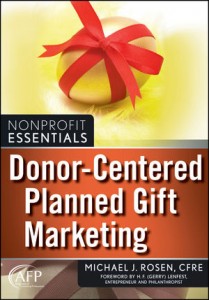As a consultant, I try to stress the importance of having a planned giving program to all of my clients, regardless of the size or capacity of the nonprofit I’m working with. However, other priorities often get moved to the top of the list and planned giving gets moved to the back burner.
But it doesn’t have to…
Looking at Planned Giving in a New Way
 Michael Rosen’s new book, Donor-Centered Planned Gift Marketing (an AFP – Wiley Nonprofit Essentials Book), helped me look at planned giving in a new way. It’s beautifully written and kept me up as I thought, “Just one more page.” Rosen has a unique ability to take potentially mind-numbing topics, like planned giving and marketing, and make them crystal clear and simple to understand.
Michael Rosen’s new book, Donor-Centered Planned Gift Marketing (an AFP – Wiley Nonprofit Essentials Book), helped me look at planned giving in a new way. It’s beautifully written and kept me up as I thought, “Just one more page.” Rosen has a unique ability to take potentially mind-numbing topics, like planned giving and marketing, and make them crystal clear and simple to understand.
As with the majority of the books I recommend, I do not earn one cent if you choose to buy this book. I’m recommending it to you because I think it’s truly a valuable resource and will help your nonprofit raise more money with simple, straight-forward thinking, which is what I’m all about.
Planned Giving Provides Opportunity
Rosen says, “While most Americans have the ability to make a planned gift, the research reveals that relatively few have actually done so and that vastly more are willing to consider such gifts.”
This means there’s a tremendous opportunity for nonprofits to educate prospective planned giving donors and receive planned gifts. While many Americans fear outliving their resources, this is the one and only way they could possibly consider making a major gift to your organization. You don’t want to miss out on the enormous potential and extraordinary generational transfer of wealth that’s just getting started.
Debunking Myths About Planned Giving
In the introduction, Rosen debunks five myths about planned giving, including myth number one, that planned giving is difficult. In this section, Rosen shows the reader that a vastly large percentage of planned gifts are bequests and stock, for which no real planned giving expertise is necessary. Almost any development director or executive director can market planned gifts and then access outside professional help as necessary for specific gifts and donors.
If you have ever heard me speak or read any of my writing on fundraising, I often break fundraising down into four steps:
- Identification
- Cultivation
- Solicitation
- Stewardship
For planned gift marketing, Rosen adds an extra step, especially important for planned giving: Education.
Most donors have never heard of planned giving and therefore, would never consider a planned gift. It’s our job to educate donors about the possibilities so they are open to exponentially larger gifts than they might be able or willing to make during their lifetimes. Rosen’s book goes into detail about how to properly educate your donors about planned giving.
In short, this is an excellent read that will help you understand the potential of planned giving in a simple, easy-to-follow manner. For Rosen’s work on the book, he won the 2011 AFP/Skystone Partners Prize for Research on Fundraising and Philanthropy. This was the first time in a decade that an author of a planned giving book won the Prize.
If you found this review helpful, or have already read Rosen’s book, share your thoughts in the comments.
Michael Rosen, President of ML Innovations, is also the host of the popular blog Michael Rosen Says. He can be reached at either website.

This is a great post, Amy. Thank you – just what I needed to read today. It’s so important to remember that PG must be donor centered to be successful.